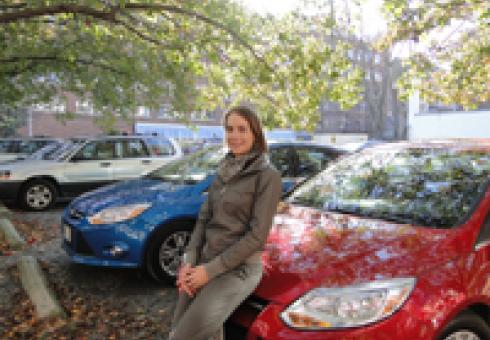Sergey Paltsev, assistant director for economic research at the MIT Joint Program on the Science and Policy of Global Change, presented at the 2014 Gaidar Forum entitled "Russia and the World: Sustainable Development."
The expert discussion “Green growth” and sustainable development” was dedicated to such topics as energy efficiency and renewable energy as the drivers of economic growthas economic growth drivers. Besides it focused on the perspectives of “the third industrial revolution”, which is not a new idea, however it opens the prospects for efficient energy use.
Oleg Lugovoy, Research Advisor, Center for Economic Modeling of Energy and Environment, RANEPA, Jeffrey Sachs, Director of the Earth Institute and Professor of Columbia University, Hillard Huntington, Executive Director of Energy Modeling Forum, Stanford University, Emmanuel Guérin, Associate Director of Sustainable Development Solutions Network (SDSN), Frederic Vidal, President of Université de Nice Sophia-Antipolis, Sergey Paltsev, Assistant Director for Economic Research of MIT Joint Program on the Science and Policy of Global Change of the Massachusetts Institute of Technology, John Laitner, Resource Economist and Independent Consultant of Economic and Human Dimensions Research Associates and Glen Peters, Senior Research Fellow of the Center for International Climate and Environmental Research of Norway, took part in the discussion.
In his opening remarks, the moderator Oleg Lugovoy defined the vector of the discussion: “It’s a discussion on how to achieve high growth rates and improve life quality without causing harm to the environment.” He also noted that the problem could not be solved by the efforts of business and public organizations alone, but depends on economic regulation.
John Laitner turned the participants’ attention to the task of increasing the quality of energy efficiency giving USA as an example, where 86% of all energy is spent to no purpose. Inefficient use of energy leads to huge costs and is a factor limiting, in Russia as well, the potential for economic development. The expert underlined that the idea of the third industrial revolution which consists of combination of interactive communications and new green technologies is getting more important.
Jeffrey Sachs reminded the participants of the discussion about the idea of a prominent Russian economist Nikolai Kondratyev on periodic economic cycles (waves) linking it to the concept of a shift in technological modes. Each of them had limited resources, but never before has the scale of economic activity been so impressive and the number of population so huge (7.2 billion people). “90 trillion dollars – this is the volume of the annual economic output,” Jeffrey Sachs noted, “and this figure tends to grow progressively. So do the CO2 emissions as well. Already today 38 billion tons of СО2 are annually emitted into the Earth’s atmosphere,” the expert noted.
However, changing the energy system profoundly and substantially over 40-50 years is quite a challenge. One of the possible solutions is to switch to alternative types of fuel or renewable energy sources. Nuclear energy, if it is safe, also has a high potential. But the most important thing, according to the expert, is to reduce coal consumption, in particular, “convince China, the country which consumes this fuel in huge volumes, to do so.”
The report by Hillard Huntington marked a turn in the discussion to the subject of shale gas. The expert noted numerous uncertainties pertaining to shale gas extraction. It is still difficult to evaluate the outlook for price policy in this field unambiguously, which is caused not only by the way it is extracted, but also the volumes of gas supply.
Sergey Paltsev agreed with his colleague. He immediately dotted the i’s noting the “platitude” of shale gas: “It does not differ from the common methane, the difference lies in the method of extraction which consists in subsurface fracture.” Answering the question “whether Gazprom has overslept shale gas revolution or not”, the expert agreed with the estimation given by the Prime Minister of the Russian Federation Dmitry Medvedev who said that “this question is quite complicated.” “Gazprom has enough gas and it can go without shale gas, given proper investment and price policy,” Mr. Paltsev summarized. He also noted that the consequences of fraction are difficult to predict. Besides, the use of huge amount of water during extraction makes its benefits ambiguous, at the same time CO2 emissions from the use of natural gas are far from zero, therefore it is impossible to say that its production can address the problem of emissions globally.
News and Outreach: Sergey Paltsev
Alli Gold Roberts
MIT Joint Program on the Science and Policy of Global Change
Policies to curb greenhouse gas emissions will come at a cost to energy producers, industry and consumers. Policymakers around the globe are working to determine the most effective and cost efficient way to reduce these emissions—from renewable energy subsidies and fuel efficiency standards to carbon taxes and cap-and-trade policies.
To tackle this challenge, Sergey Paltsev from MIT and Pantelis Capros from the National Technical University of Athens have come together to assess which methods and metrics are best for calculating the cost of climate policies. In their study, published this week in Climate Change Economics, they find that there is no one ideal metric for climate mitigation policies, but measuring changes in consumer welfare is one of the most appropriate techniques.
“With many of these regulations, the total costs are often less visible to consumers because the true costs are not reflected in the price of energy, but distributed to other sectors of the economy,” says Paltsev, the assistant director for economic research at the MIT Joint Program on the Science and Policy of Global Change. “The true measure of the cost of a policy is reflected in the change in consumers’ behavior, something that economists call as ‘change in welfare,’ but it is hard to convey this measure to policy makers and general public.”
In the study, the researchers compare different concepts that are used to inform the public about the cost implications of climate change. They consider two major modeling types where costs are calculated, energy system models and macroeconomic models. Energy system models focus solely on the energy sector and treat the rest of the economy as a given. Macroeconomic models represent the energy system as part of the entire economy and provide more detailed information on the various sectors. Within these approaches there are a variety of metrics used to calculate the cost of a climate mitigation policy.
After studying the cost metrics associated with each modeling approach, the researchers compared the metrics used by a team of international researchers to better understand the impacts of the current EU emissions targets (the EU Energy Modeling Forum 28 study). They find that there are large variations in cost estimates and most metrics are not directly comparable, which makes it difficult for policymakers to interpret the results of these studies.
Paltsev says there is no ideal metric for costs, but it’s clear that some approaches are more effective than others. For example, carbon prices and marginal abatement cost curves are unable to reflect the full impact of the policy on the economy. In addition, energy system models do not always take into account the full cost of a climate policy—particularly the economic impacts of policies interacting with one another. The authors recognize that depending on the objectives, other metrics and modeling techniques may be appropriate. They conclude that measuring changes in consumer welfare or consumption is an effective approach that should be used by policymakers to evaluate climate policies.
By Vicki Ekstrom
Read the 2013 Energy and Climate Outlook
As international negotiators discuss global efforts to confront climate change at the 19th United Nation’s Conference of Parties (COP19), a group of MIT researchers suggest that the current regional efforts may not be enough to avoid the dangerous consequences of rising emissions.

“As our global population swells to more than 10 billion by the end of this century, climate change is one of the forces of global change that will shape how the world feeds, shelters, transports, and otherwise attends to this growing mass of people,” says John Reilly, co-director of the Joint Program on the Science and Policy of Global Change and an author of the 2013 Energy and Climate Outlook. “Our latest Outlook is a window into the future as we view it in 2013, but it is still in our power to change what we see by taking action.”
While much of the Outlook’s projections remain the same as in their 2012 Outlook – highlighting that large or developing countries will play a greater role in shaping our global challenges over time – shifting trends and new and updated data have led to subtle changes. One such trend is the growing use of natural gas and, to a lesser extent, renewable energy. Policies such as the European Union’s Emissions Trading System (and assuming Europe continues on its announced post 2020 policies)helped bring about some of these changes; cutting Europe’s coal generation in 2050 by almost half compared to the last Outlook. The U.S. is also expected to generate 35 percent more renewable energy and 15 percent more natural gas by 2050 compared to the 2012 Outlook.
Taking into account these resource and policy changes, the researchers project global natural gas consumption by 2050 to be 8 percent higher than their 2012 estimates, with China’s consumption alone more than tripling. They also project global consumption of renewable sources by 2050 to be 13 percent higher, while coal and oil usage will sink slightly (3 percent).
Changes in the global energy mix are partly responsible for a 12 percent dip in the projected CO2 emissions by the end of the century. Yet, these emissions are still projected to be 95 percent higher than in 2010. Even with cumulative emissions sinking slightly, the Outlook projects the world will warm by 3 to 6°C by 2100 compared to 2000, with the median forecast at 3.8°C.
“With natural gas becoming more and more important to the global energy mix each year, and recent policy efforts spurring an increased use of renewables, we do believe there will be slightly fewer emissions than we originally forecasted,” says Sergey Paltsev, an author of the study and the assistant director for economic research at the Joint Program on Global Change. “But, while growing at a slightly lesser rate, emissions are still increasing, and if they continue to grow we might experience very harmful consequences.”
Building on the models used for their 2012 Outlook, the researchers identify the hottest and coldest regions and the range of uncertainty. They find that generally the polar areas display the most warming, with Northern Canada and Siberia warming between 6 and 12°C by 2100. Meanwhile, North America, Europe and Asia can expect temperatures to warm by as much as 4 to 8°C, and Africa, Australia and South America can expect temperature increases between 3 and 7°C. The researchers also warn there could be very damaging consequences from an increase in extreme precipitation events, such as floods. Their analysis shows most land areas will become wetter, while over the ocean and Tropics a few regions could become drier.
“Taking into account the vast uncertainty in climate projections, even in our most optimistic scenario we see that these changes will surely impact food and water resources, among other changes,” says Erwan Monier, an author of the study and a scientist at the Joint Program on Global Change.
As in the 2012 Outlook, the researchers emphasize that further cuts in developed countries would be useful. But only 13 percent of emissions are expected to come from these countries by 2100, meaning their efforts will have less of an impact over time as the share of emissions from other nations increases. Emissions from countries outside the developed world could grow by almost 150 percent by the end of the century.
Reilly, Paltsev and nine others based their projections on the United Nations' estimate that the world's population will grow to more than 10 billion by 2100. Using their computer modeling system to project how this growth would affect our energy and climate, they then incorporated pledges made by G20 nations at international meetings in Copenhagen in 2009 and Cancun in 2010 to cap emissions by 2020.
“As difficult as the progress made in Copenhagen and Cancun was to achieve, far more effort is needed to limit greenhouse gas concentrations to levels that avoid dangerous climatic consequences,” the authors write, stressing the importance of the ongoing international talks.
As the U.S. and other large nations experience the benefits of a natural gas boom, smaller countries – from Tanzania to Cyprus – are hoping to reap the rewards too and use the resource to spur their economies. But in a new study, MIT researchers warn them to proceed with caution.

“While natural gas is often cheaper than oil and gives off fewer emissions, developing the resource comes with risks, especially for smaller nations,” says Sergey Paltsev, an author of the study and a principal research scientist at the MIT Energy Initiative. “The cost for these smaller nations makes up a larger portion of their economies, so before spending the money, they need to have the proper expectations.”
In collaboration with the Cyprus Institute, the MIT researchers take an independent look at the economics around developing the resource using Cyprus as an example. They find that it will take the country about five years to put their natural gas resource to use, and the required investments will make up to a quarter of the country’s Gross Domestic Product (GDP).
“That’s a substantial amount of a country’s economy dependent on a resource that has proven to be unpredictable in the past,” says Paltsev, who is also the assistant director for economic research at the MIT Joint Program on the Science and Policy of Global Change. “Natural gas development is so new to such regions, and the global gas market is changing so rapidly, that there’s a large amount of uncertainty.”
This is the message the researchers will bring to a November meeting with Cyprus decision-makers, meant to help the leaders plan a path forward with realistic expectations in mind.
The Case of Cyprus
What’s happening in Cyprus is a good model for other countries like it that are exploring natural gas, according to Paltsev.
The small nation has been teetering back from a near collapse of its banking industry and searching for revenue. When a major natural gas reserve was discovered off its coast two years ago, Cyprus leaders saw it as a golden opportunity.
The latest estimate of the resource at that site, given earlier this month, shows about 5 trillion cubic feet of gas. To put that into context, the researchers cite a 2013 BP report showing the global supply of natural gas to be about 6,600 trillion cubic feet, with Russia’s reserves alone being 1,160 trillion cubic feet.
“These numbers tell us that, while this is a significant find for a country the size of Cyprus, it’s only a small fraction of the global resources,” says Francis O’Sullivan, the director of research for the MIT Energy Initiative. “Most likely, Cyprus will never be a major player in the global gas markets, but that doesn’t mean natural gas can’t benefit the country’s economy if developed properly.”
One trillion cubic feet of natural gas is enough to meet the needs of 5 million households for 15 years, according to the American Gas Association. With the population of Cyprus being just around a million, the study shows that Cyprus has enough natural gas to power the country for nearly a century – while significantly reducing its use of foreign oil.
LNG versus a Pipeline
An ample resource for domestic use, the Cyprus government has made plans to build a Liquefied Natural Gas (LNG) plant and export the resource to such place as Europe and Israel.
LNG has been the preferred option over building a pipeline because of political tensions in the area. The island has been divided since the mid-1970s, with Turkey occupying the northern half.
While a clear political maneuver, building an LNG terminal would also create jobs and raise revenue. Depending on the tax scheme, it may raise $1.5 billion in taxes. Still, it would cost about $6 billion to build, for a country that has a GDP of about $25 billion. The cost of building an LNG terminal is far more than the cost of building a pipeline, though LNG offers greater flexibility to adjust production to changing natural gas prices and market supplies – perhaps outweighing the upfront costs.
“The discovery of natural gas has created exciting opportunities for Cyprus and could transform the country’s energy system and position in the region,” O’Sullivan says. “But the cost of developing the resource makes up about a quarter of the country’s economy. That’s not insignificant, and it’s a major risk if it fails.”
O’Sullivan and Paltsev warn that even projects that start out having clear economic gains can become less profitable because of poor technical planning and execution or bureaucratic and regulatory delays.
“Prices change, projects get delayed, overrun costs pile up. These are all unforeseen risks that can come up and must be properly mitigated,” Paltsev says.
The study, funded entirely by the Cyprus Research Promotion Foundation, is part of a larger report that will further take into account the changing dynamics of the regional and global gas markets – giving a comprehensive view of the implications for the long-term development of natural gas in Cyprus and other like nations. The researchers expect to finish that larger report in August 2014.
Photo Credit: ©iStock.com/MsLightBox
Karplus, Paltsev recieve award for study on the impacts of vehicle efficieny stanards
Valerie Karplus, Research Scientist, and Sergey Paltsev, Assistant Director for Economic Research with MIT’s Joint Program on the Science and Policy of Global Change, were awarded the 2012 Pyke Johnson Award at a ceremony last night during the annual meeting for the National Research Council's Transportation Research Board. The Pyke Johnson Award recognizes the best paper in the area of planning and the environment.
Published in November in the journal Transportation Research Record, the study looks into the new vehicle efficiency standards. The standards are considered one of the landmark environmental achievements of President Obama’s first term, and have been touted as a way to save consumers more than $1.7 trillion at the pump and cut vehicle emissions in half. Karplus and Paltsev look behind the numbers to understand the full energy and economic impacts. 
“Common thinking in Washington holds that any policy that seems to advance technology without creating new taxes must be a no brainer for the country. That misses the broader economic impact,” says Karplus. “As my colleague says, you may see more money in your front pocket at the pump, but you’re financing the policy out of your back pocket through your tax dollars and at the point of your vehicle purchase.”
Of the research, University of Maine environmental economist Jonathan Rubin, chair of the Transportation Energy Committee of the Transportation Research Board, says, “The research of Dr. Karplus on the energy and climate impacts of the nation’s fuel economy standards for our cars and trucks makes an important contribution to policy-making based on science.”
The new fuel standards require automakers to install pollution-control technology to improve the fuel efficiency of cars by 5 percent and light trucks by 3.5 percent with each new model year starting in 2017. Karplus and her colleague simulated the proposed standards, and found that while drivers of these more efficient vehicles will no doubt save at the pump, they could spend several thousands of dollars more when buying their new car. Even more troubling, diverting efforts toward improved vehicle efficiency distracts attention away from policies that would target the broader economy and reduce fuel use or emissions more cost effectively, such as a carbon tax.
Estimates of how costly the policy would be – in terms of both direct costs to consumers and the larger rippling costs to the economy – hinge on the relative cost of the technology available to improve efficiency. The shorter the time frame automakers are given to develop the technology and produce more efficient vehicles, the less time there will be for technological progress and other factors to drive down costs and the more consumers will need to pay upfront. Emissions and oil imports will drop – both due to increased fuel efficiency and as the higher vehicle costs weighs on consumer budgets – but will be offset as consumers face lower costs per mile traveled, incentivizing more driving.
Karplus hopes her results will help policymakers make more informed decisions going forward. She credits that to the innovative method she used, which weaves engineering and technology constraints into a broad economic framework and allows researchers to test the cost and other impacts of a policy at different levels of stringency. This method inherently takes account of life-cycle emissions, as well as impacts that transmit across fuel markets by affecting prices. For example, a policy might only consider gasoline use by plug-in electric hybrids, but that “tailpipe measure” doesn’t take into account the emissions created from building, transporting and recharging those batteries. Her approach does.
“There are a lot of hidden costs to a policy like this,” Karplus says. “This model doesn’t allow you to ignore other important aspects of the economy and energy systems. It requires you to be explicit about your technology and cost assumptions. It provides a framework that allows lawmakers to look at all the available information on costs and the state of the technology and decide how to best create or update policies.”
MIT’s Joint Program on the Science and Policy of Global Change has pegged the annual cost of the proposed cap-and-trade legislation in Congress at $400 per U.S. household. But estimating the cost of doing nothing is far more difficult.
Sergey Paltsev, a principal research scientist in MIT’s Joint Program on the Science and Policy of Global Change, was the lead author of a recent report that analyzed the costs of climate legislation currently being debated in Congress. The analysis looked at the costs associated with the Waxman-Markey bill that was passed in June, and found the bill’s cap-and-trade provisions would have an average annual cost per U.S. household of $400. The study did not provide a comparison of what costs would be for a “no policy” case — in other words, the costs that would result from unmitigated climate change, or from other causes such as air or water pollution that might be associated with unregulated burning of fossil fuels.
Q: Have there been any changes proposed since the original bill was passed, or that are currently under discussion, that would make much of a difference in this cost estimate, one way or the other?
A: Currently, the already-passed Waxman-Markey bill and the Senate version, the Kerry-Boxer bill, are similar in emissions-reduction targets and total offsets. There are some minor differences, but unless major changes are proposed during the discussions in the Senate, the overall costs are similar. It should be noted that now the heat of the discussions are on the emission allowance allocation, which would determine who gets the emissions rights for free, who has to pay for them, and how the permit revenue will be spent. The outcome of this process would benefit or hurt certain industries or households of different income classes. The decisions about revenue allocation would affect who gains and who loses more, and as the stakes are high, there are many parties trying to influence the outcome. But the average economic burden, which is what we calculated, is not much affected by the allowance allocation.
Q: Apart from measures that are specifically being considered now, did your analysis suggest any different approaches, or modifications of the present proposal, that would bring about any significant reduction in these costs?
A: We have done other studies where we have considered issues related to the design of cap-and-trade or carbon tax systems. Ultimately, the cost of the policy is determined by the reduction targets, the possibility of banking or borrowing of permits over time, the amounts of offsets, and any additional measures directed at greenhouse gas reduction, such as renewable electricity standards, subsidies to carbon-free technologies, building standards, energy efficiency measures, etc. For the same reduction targets, overall costs are lower if there are fewer additional measures. However, these additional measures are popular because they allow hiding the true cost of the policy. For example, renewable electricity standards would reduce carbon price but increase the overall cost to the economy. As carbon price is a more visible indicator and overall cost is harder to measure, legislators might prefer to introduce such standards despite their economic inefficiency, simply because they create an illusion of achieving a target at a lower cost. At the same time, as I have already mentioned, distribution of allowance revenue could reduce the impact on, for example, low-income families or coal-producing regions, and we have a forthcoming study addressing this issue.
Q: Can you address how the costs that could result from a “no policy” case might compare with the costs of the proposed regulations?
A: In the case of “no climate policy,” I think it is more appropriate to talk about "damages" instead of “costs,” because there are some things that can be easily associated with dollar amounts and there are other things that are harder to quantify and to put a price tag on. At the MIT Joint Program we have done studies where we are trying to quantify the costs associated with the impacts of climate change on agriculture and coastal infrastructure, and of air pollution on human health. These are easier to quantify. However, there are many other important effects that cannot be convincingly put into a dollar measure, and for this reason we have not tried to estimate the economic and environmental effects of a no-policy path. Consider, for example, the main icon of a climate change — polar bears. How can one put an appropriate cost in dollar terms for a potential disappearance of polar bears due to melting Arctic ice? Or, as another example, on a coral bleaching due to increasing ocean temperature and acidification? Some people even argue that climate change is a strategic problem that should not be considered in terms of a traditional “benefit-cost” approach.
In our analysis of the Waxman-Markey bill we focus on estimating costs of the stated targets. We always stress that there are many uncertainties in our cost estimates and we try to quantify these uncertainties, but the uncertainties in the damages estimates are much larger.
Some people argue about yet another aspect of the problem. Societies have many important issues where resources are needed — to name just a few, a fight against hunger and poverty, improved access to medical facilities and education, fighting AIDS and malaria, and providing a better water supply. Climate change is an important problem, but is it diverting resources from other no-less-important problems? There are plenty of links between climate change, poverty, water supply, and diseases — but with scarce resources, is it better to focus on solving climate change or, for example, directly on fighting poverty? Obviously, we should try to do both. But where should the emphasis be? These are tough questions: How do we equate a potential loss of life of a polar bear with that of a hungry child in Africa now?
More...
Will putting a price on carbon increase the use of renewables? — The cheapest way to reduce carbon dioxide emissions is probably to put a price on them. One way to do that is a direct tax. Another is a cap-and-trade system, where the government sets an overall cap on emissions, but individual businesses trade emission allowances. But surprisingly, a carbon penalty may do little to increase reliance on renewable energy or reduce petroleum consumption.
Putting a price on carbon would certainly reduce the use of conventional coal-fired power plants. Coal emits more carbon dioxide than other fossil fuels, and its price would more than double. But natural gas would see only a modest change in price: in the short term, it would probably replace coal as the chief source of power. Oil prices wouldn't change much, either.
But unless the costs of wind and solar power come down or nuclear energy proves politically viable, the cheapest way to reduce emissions in the long term would be to capture carbon dioxide from coal plants and sequester it underground, according to a study by MIT's Joint Program on the Science and Policy of Global Change. If the goal is to increase the use of renewable energy, says Sergey Paltsev, principal research scientist at the MIT joint program, governments may have to mandate its use.
More... in the January/February 2009 issue of Technology Review










